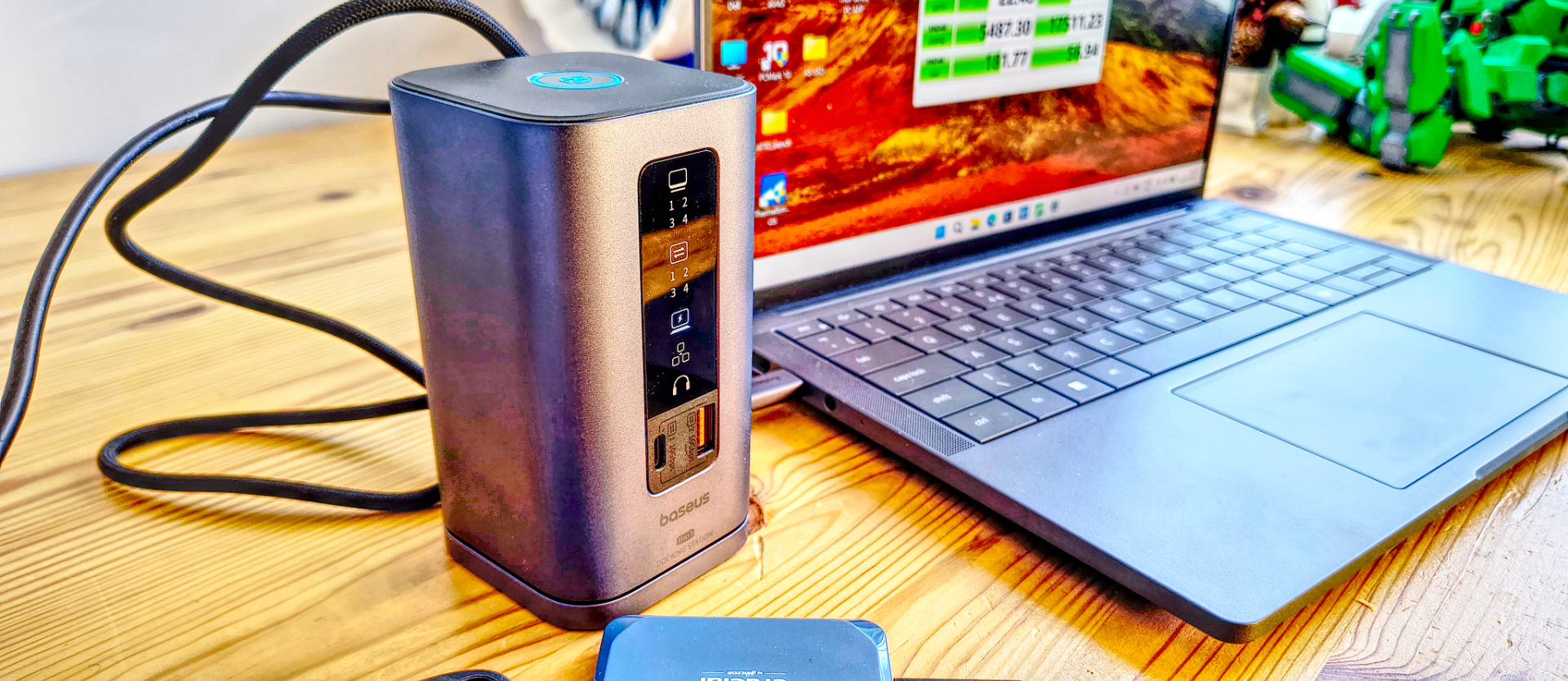TechRadar Verdict
The Baseus Spacemate 11-in-1 sits firmly between the rock of laptops with only USB-C and the hard place that is providing the connectivity that Thunderbolt actually delivers. The lack of an included PSU is the dealbreaker, among others.
Pros
- +
Attractive design
- +
Indicators LEDs
- +
Self contained
- +
Magnetic base
Cons
- -
Hardwired cable
- -
Price is almost that of a TB dock
- -
No PSU included
Why you can trust TechRadar
Baseus Spacemate 11-in-1: 30-second review
While some peripheral manufacturers have jumped into creating Thunderbolt 5 docks despite the lack of machines with this port or peripherals to use with them, more pragmatic minds are still backing USB-C as a docking technology.
Baseus security is one of those less ambitious brands, and the Spacemate 11-in-1 Docking Station for Windows is an example of the cost-effective solutions it has created.
A basic USB-C dock that is meant to provide a simple single-cable connection to a laptop, enabling it to be hooked up to power, monitors, a wired network and a host of USB peripherals quickly and easily.
And, with an asking price of only $129.99, decking out an entire department with these easy-to-deploy devices won’t bust the budget.
However, this device operates within the limitations of USB 3.2 Gen 2, and therefore, a single 10Gbps data connection is shared among all connected devices, many of which could utilise all of that bandwidth.
That’s unlike Thunderbolt 4 docks, where the total of 40Gbps allows multiple connections to be handled at full speed without compromise.
It also assumes that you brought your 100W USB-C charger to the office, since it doesn’t come with a PSU, making it slightly less convenient.
Sign up to the TechRadar Pro newsletter to get all the top news, opinion, features and guidance your business needs to succeed!
If you aren’t intending to connect four monitors and do large file transfers, then this lack of bandwidth might not be an issue for you.
What I liked about this dock is that it features a front-facing display that indicates what is currently connected, and it comes with a magnetic base that allows it to be securely attached to a desk, preventing it from being easily knocked off.
The only significant issue here is that cheaper Thunderbolt docks are only another $30 or more, and if you have that port, it provides a superior experience over USB-C.
Probably not a candidate for the best laptop docking stations , but an interesting diversion from the typical offerings.
Baseus Spacemate 11-in-1: Price & availability
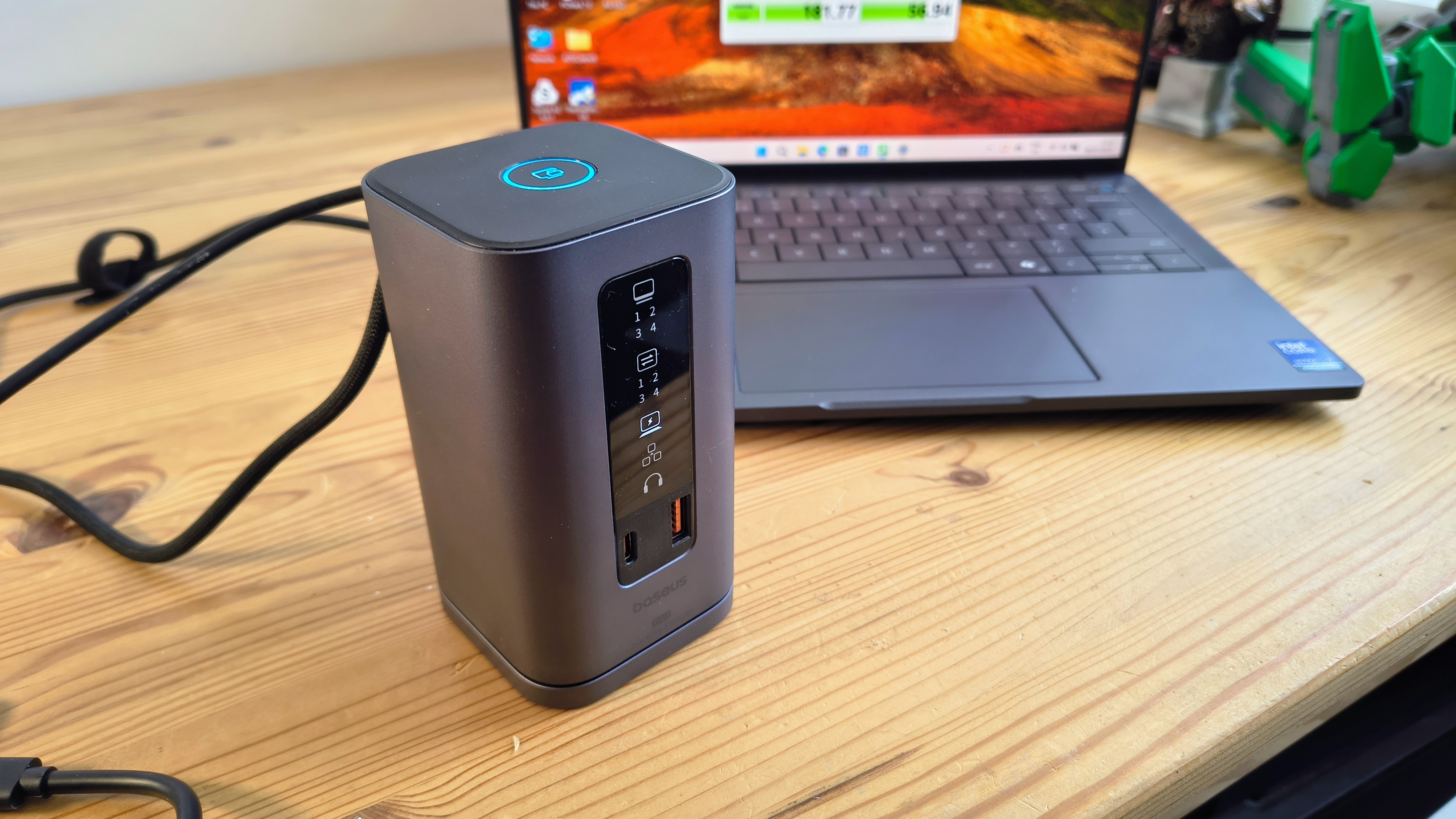
- How much does it cost? $129.99/£111/€120
- When is it out? It’s available now
- Where can you get it? Direct from Baseus or from Amazon
Direct from Baseus, the Spacemate 11-in-1 is available for $129.99 to US customers, and it can be found for a similar price on Amazon. In Europe, it can be purchased for £130 via Amazon in the UK and €128.34 on other European Amazon sites.
While this is not an outrageous price, it’s worth noting that Ugreen offers the Revodok Pro Docking Station 11-in-1 with remarkably similar specifications, which sells for only £39.98 in the UK and $43.99 in the USA through Amazon.
However, if you’re willing to pay a little more, the Ugreen Revodock Max 208 is available for $159.99, which is a full Thunderbolt 4 dock that comes with a 140W PSU.
The fact that the Spacemate doesn’t come with a PSU makes it a much less attractive deal.
- Value: 3.5 / 5
Baseus Spacemate 11-in-1: Specs
Compatibility: | USB-C |
Number of Ports: | 11 |
Ports front: | 1x USB 3.2 Gen 2 Type-C, 1x USB 3.2 Gen 2 Type-A |
Ports back: | USB-C power in, 1x USB 3.2 Gen 2 Type-A, 1x USB 2.0, 2x HDMI, 2x DisplayPort, 1GbE LAN, Audio in and out |
Downstream power: | 1x 85W USB-C |
Upstream power: | 100W USB-C |
Size: | 6.6 x 6.6 x 12.3 cm (W x D x H) |
Weight: | ?485g |
Accessories: | Magnetic base |
Baseus Spacemate 11-in-1: Design
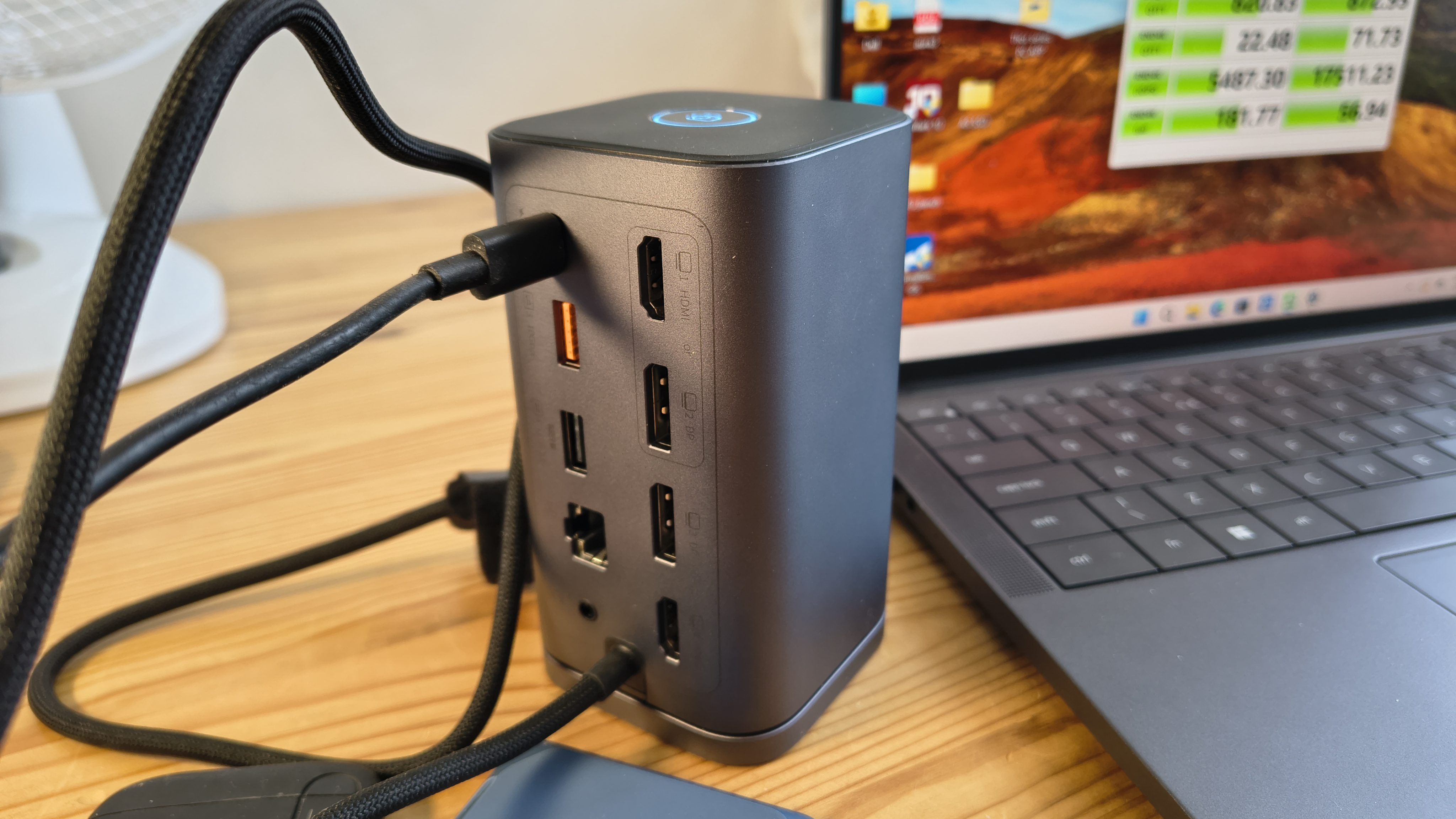
- Magnetic base
- Integrated USB-C cable
- No PSU
- Screen lock
When I first took this dock out of its packaging, it drew an uncanny resemblance to a recent Ugreen power bank I reviewed, as it has the same overall shape and proportions.
It turned out to be slightly larger than the Ugreen Nexode 20000 mAh Power Bank, and a good amount lighter, at just 485g.
It’s so light that those who designed this hardware made an interesting choice to avoid it being easily brushed off the edge of a desk. The dock comes in two parts: the dock hardware and a base that it magnetically connects to.
On the underside of the base is an adhesive coating intended to secure it to the desktop, although I must admit that I didn’t glue mine to it. Not sure if this is a good idea if you often like to reorganise, but the magnets that hold the dock in place are strong.
As there isn’t a specific direction that the base must connect, you can change the direction in 90-degree increments, making it easy to turn it around to attach cables to the rear.
This layout is curious but not offensive, but the next revelation about this dock I didn’t care for at all. The USB-C cable that connects the dock to the computer is permanently attached.
That means that if it became damaged in any way, then the whole device is junk, unfortunately. Not a good choice, although it simplifies the packaging.
Another notable omission is that this dock doesn’t come with a power supply. That’s an even bigger issue, because typically a person who moves between home working and an office environment doesn’t want to have to carry a PSU with them. It also ruins the one-cable-connection model, to a degree.
The dock will work with only the laptop connected, but it will not be charging, and the power demands of the dock will be coming from the laptop battery.
And, if you have a laptop that needs 100W to charge, it will only get 85W through this dock, because the dock needs power that isn’t considered by the laptop’s PSU.
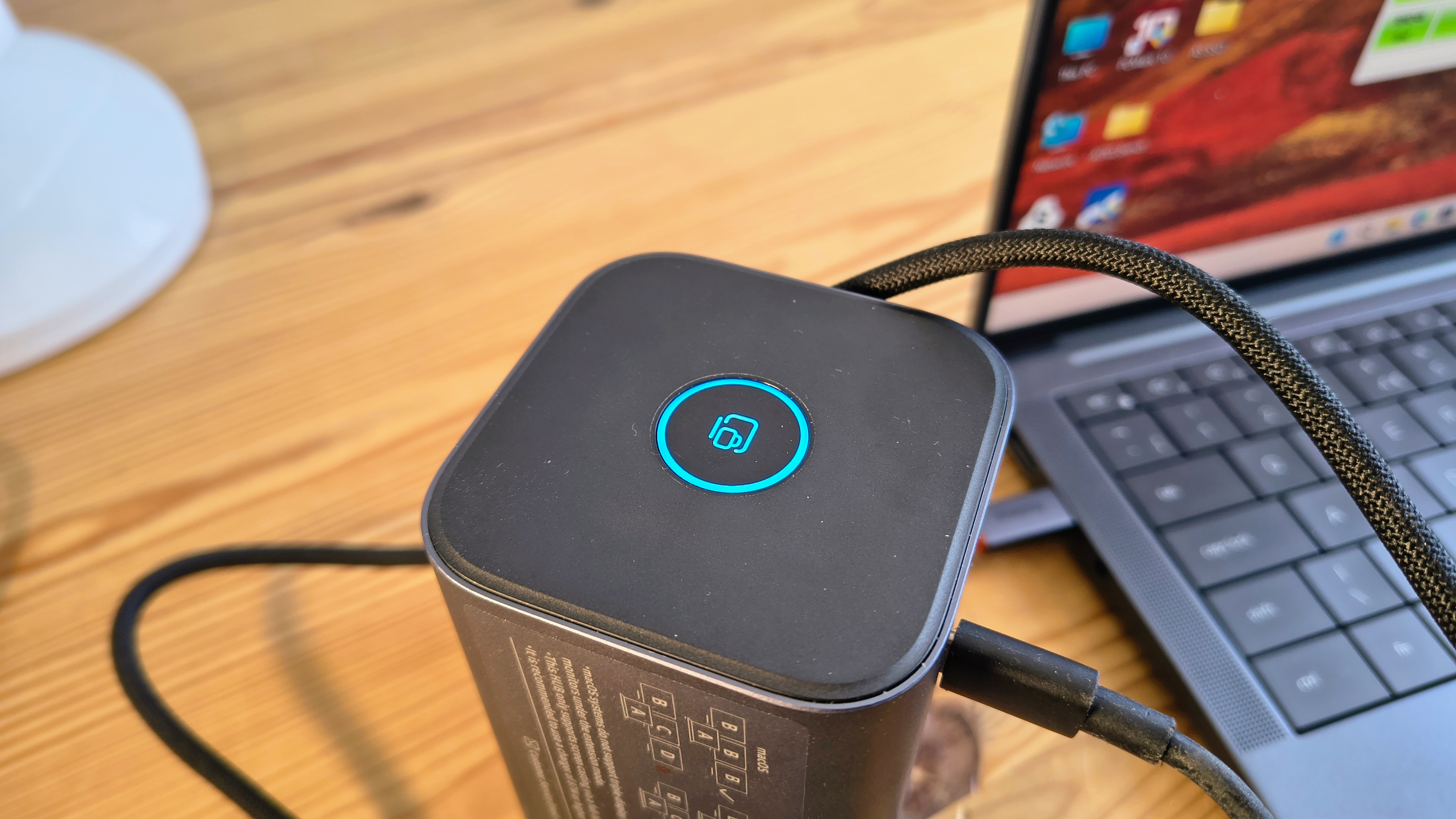
For some users, all or some of those caveats are deal breakers, but I’d single out the lack of a PSU as the most problematic, since you can buy a Thunderbolt dock with a PSU for not much more than this costs.
On a positive front, one unique feature of this dock is that it has a display on the front that indicates which ports on the back are currently active. Another feature is that the top of the dock has a button you can press to return the laptop to the login screen.
Optimistically, I had wondered if the top button might be a fingerprint reader, but it merely performs the same job as selecting ‘Lock’. The same can be achieved with Windows Key + L, which requires two fingers, not one.
Overall, there are aspects to this design that I like and others, like the integrated cable, I don’t care for at all. Ignoring the cute status LEDs, my biggest issue is that it doesn’t include a PSU, something every potential customer will need.
- Design: 3.5 / 5
Baseus Spacemate 11-in-1: Features
- Bandwidth management
- Power management
We’re now entering the part of the review where I cover the subject of dock resources and the degree to which they’ve been oversubscribed.
While even the most expensive Thunderbolt docks do this, making the assumption that customers won’t plug something into every port and expect it to work perfectly, the issue is significantly amplified with USB docks.
If we set aside the displays and the bandwidth they use, there are no fewer than three USB 3.2 Gen 2 ports and a 1GbE LAN port that consume more than three times the bandwidth that a single USB 3.2 Gen 2 cable connecting the laptop offers.
Therefore, if you copy a file between two USB SSDs that are rated for Gen 2 transfer at 1000MB/s, you will only achieve half that performance, as one uses 500MB/s for reading and the other 500MB/s for writing.
So, where does USB-C DP Alt Mode come in this calculation? USB 3.2 has an alternate mode where each of the four wires used for USB can be subverted to carry a video signal, allowing for the connection of up to four monitors, in theory. And compression allows those data streams to support 4K, depending on the colour bit depth and format.
However, most laptops don’t support more than three monitors, and many Macs only support two. If you start attaching lots of monitors, the bandwidth available for other USB devices will be reduced.
While you are free to plug whatever you fancy into this dock, and it will try its best to make it all work to some degree, the baseline bandwidth of 10Gbps and four wires means that the practical limits can be found quite rapidly.
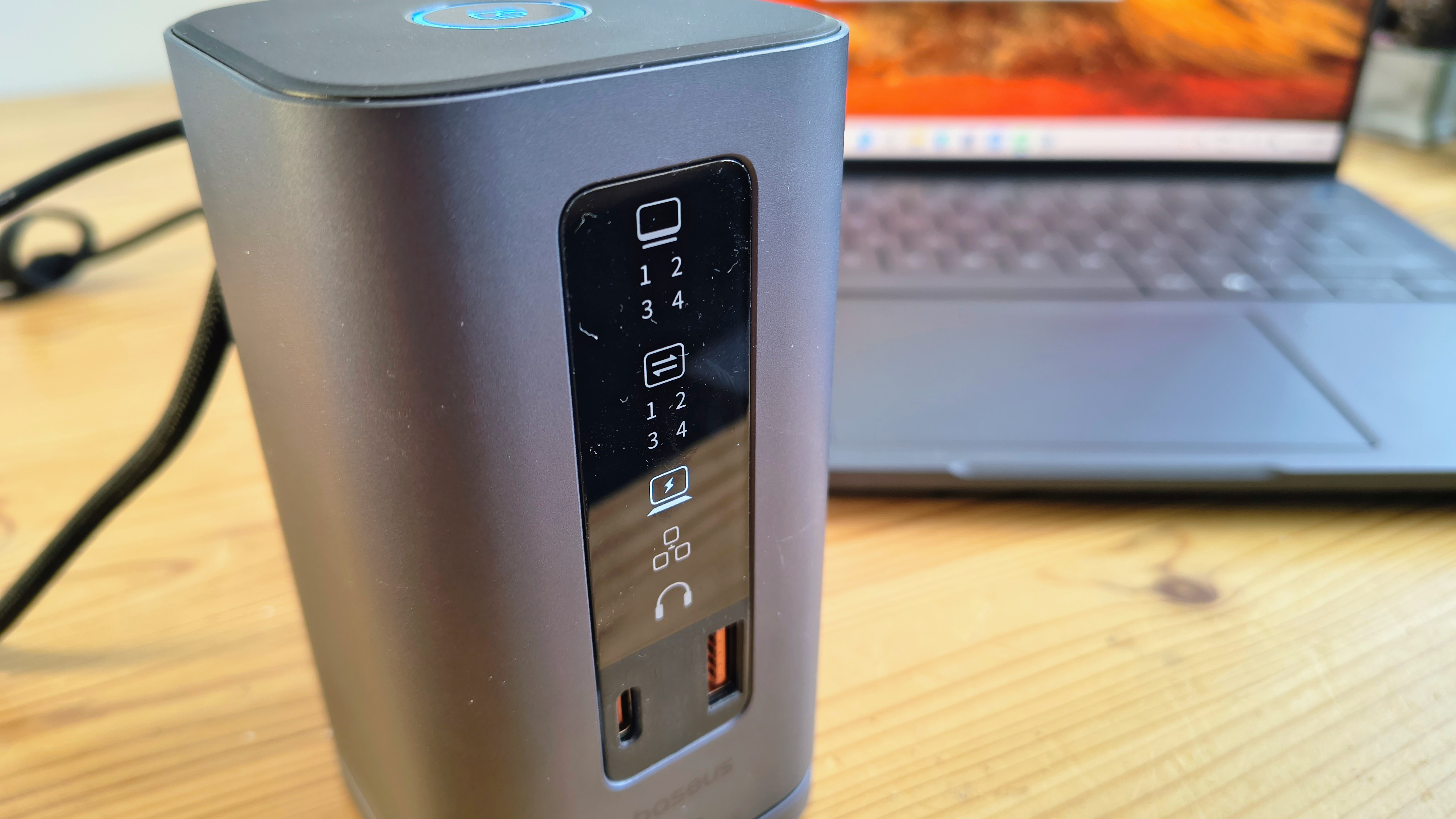
The flip side of these limitations is the distribution of power, as this dock is designed to have a 100W PSU attached to it and then pass 85W to the laptop to charge it. That leaves 15W for the operation of the dock and the power demands made by the USB ports. As each Type-A port should be able to deliver 7.5W, those numbers don’t add up.
The likelihood is that charging power will be reduced below 85W if connected USB devices are using more of the total power budget, which may be an issue if you have a powerful laptop that requires at least 85W to charge while in use.
To be clear, I’m not being critical of Baseus and how this dock was designed; these are the same uses that almost every USB dock is confronted with. However, it’s essential that customers understand that having eleven ports is more of a convenience than an invitation to try to use them all.
- Features: 3 / 5
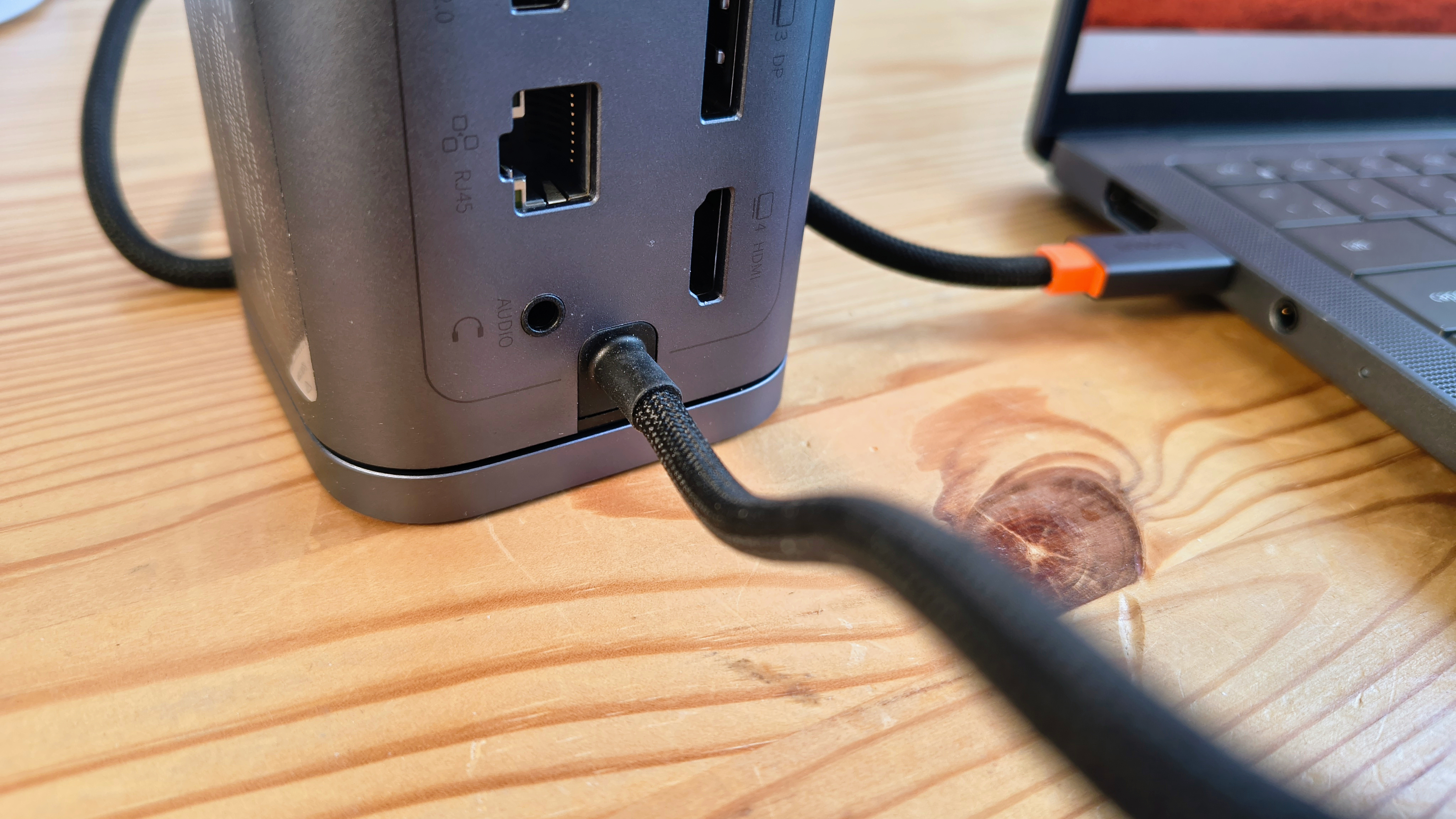
Baseus Spacemate 11-in-1: Performance
- 10Gbps reality
I tested this dock with a new Crucial X10 SSD. It read at approximately 852MB/s and wrote at 863 MB/s from a connected Intel Ultra 200 series laptop with Thunderbolt 4/USB 4 ports.
That would suggest that to make things work more smoothly, the dock strategically holds back some bandwidth in reserve.
I then plugged in a Crucial X8 on a Type-A port and copied some large files. This reduced the performance of the transfer to about 518MB/s and on the CrystalDiskMark test to the X10 to around 440MB/s.
Attaching a 1440p monitor and playing a YouTube video reduced some of that performance, and increasing the resolution and bit depth took even more.
I could have conducted more tests, but it was already evident that the 10Gbps pie can only be divided in predictable ways, and that’s the practical limit of a dock using this technology.
If you want to use this dock to connect multiple screens, storage, and a LAN network, then it will utilise your 10Gbps connection and share it among the devices. If you have extra ports on your laptop, you will get better performance using those than connecting storage to the dock. However, this is true of any dock technology, not just this one.
Overall, it works as I’d expect, which, if you don’t have overly high expectations, is fine.
- Performance: 3 / 5
Baseus Spacemate 11-in-1: Final verdict
I think that if this dock had come with a detachable USB cable and a 100W power supply, I might have been less critical of it and its price point. However, I’ve also concluded that USB docks offer a limited experience, and the bandwidth of Thunderbolt is undoubtedly the real deal.
If you only have USB-C ports, then this can be useful, but don’t expect miracles with only 10GB/s of bandwidth to work with.
Baseus Spacemate 11-in-1: Report card
Value | On the pricey side for a dock without a PSU | 3.5 / 5 |
Design | Odd design with magnetic base, but nicely engineered | 3.5 / 5 |
Features | Does what it can with 10Gbps and 100W of power | 3 / 5 |
Performance | Not ideal for file transfers | 3 / 5 |
Overall | Nearly the price of a cheap Thunderbolt dock costs | 3.5 / 5 |
Should you buy a Baseus Spacemate 11-in-1?
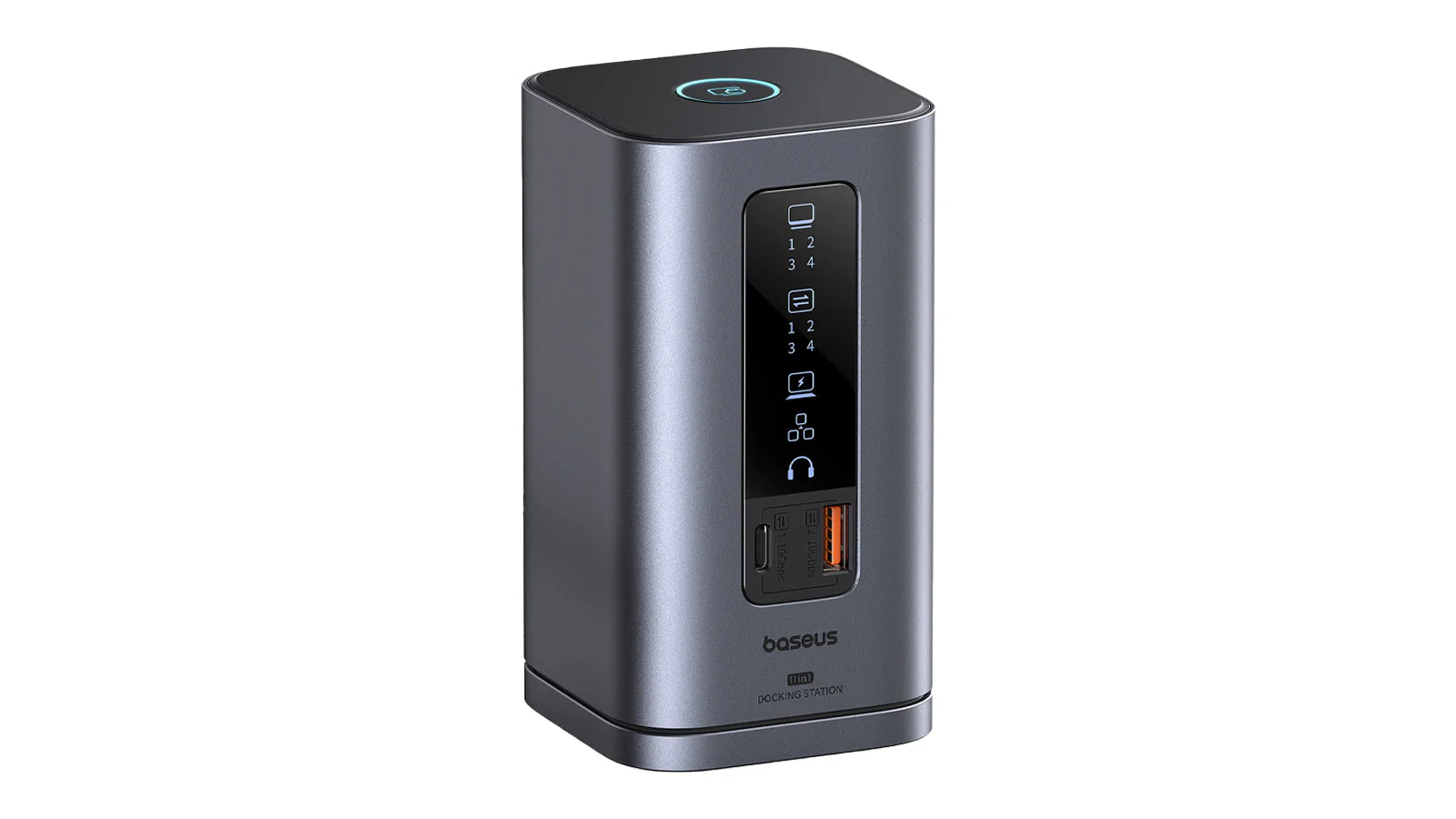
Buy it if...
You only have USB-C
If you only have USB-C on your laptop, then this hardware will offer almost exactly what the majority of USB docks do. There are cheaper options, and others that come with a PSU, but the build quality of this one is decent, and it’s simple to deploy.
Don't buy it if...
You have Thunderbolt
While this dock might work with a Thunderbolt port if it downgrades to USB 3.2, a much better experience can be had with a Thunderbolt dock.
You need 140W charging
Many Thunderbolt docks offer 96W or even 100W, as the technology should be able to transfer up to 240W in theory, but most docks stick to the original USB PD, which is limited to 100W using a solution based on 20V using USB Type-C cables rated at 5A.
If you need more power, then a Thunderbolt dock and cable are probably a good idea.
Also consider
OWC Thunderbolt Dock
A high-quality dock from OWC, this design has eleven ports and offers 90W charging for a Thunderbolt-connected laptop. What it lacks is a dedicated monitor port, but adapters for HDMI or Display port from Thunderbolt are available.
Check out our OWC Thunderbolt Dock review
CalDigit Thunderbolt Station 4
The CalDigit Thunderbolt Station 4, or TS4 as it is also known, is a full-featured Thunderbolt dock that works with Thunderbolt 4/3 and USB-C.
It is not designed to be a portable dock but specifically to support a laptop user who comes to the office and wants a single cable connection to the network and a host of peripherals. To that objective, it has no less than 18 ports and can deliver up to 98W for charging a connected system. But, it is expensive.
Check out our CalDigit Thunderbolt Station 4 (TS4) review
Mark is an expert on 3D printers, drones and phones. He also covers storage, including SSDs, NAS drives and portable hard drives. He started writing in 1986 and has contributed to MicroMart, PC Format, 3D World, among others.
You must confirm your public display name before commenting
Please logout and then login again, you will then be prompted to enter your display name.
